  |
City of GlasgowGlasgow Buildings
|
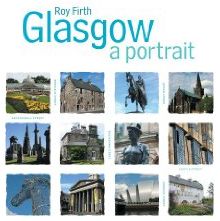 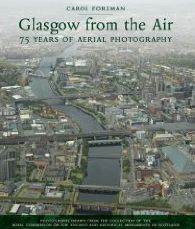 |
Photographs of the varied architecture
in the City of Glasgow
|
Dundas
Vale Teachers' Centre on New City Road in Cowcaddens. Built
in 1837, the Normal School for the Training of Teachers ( later named Dundas Vale College ) was designed by David Hamilton. It
was the first institution in Britain specifically for the professional training of teachers. |
|
Dundas
Vale
Teaching Centre in Cowcaddens |
|
RSAC Building in Blythswood Square |
|
Blythswood Square Blythswood
Hill was developed
in the late 18th and early 19th centuries. It housed the wealthy merchants and shipping magnates of Glasgow in Georgian townhouses. Blythswood Square is at the centre of the area. |
Pavilion
Theatre in Bath Street
( built 1901-1904 ). One of Glasgow's oldest theatres, the Pavilion Theatre of Varieties opened on 29 February 1904 as a Music hall. It is a category A listed building. |
The High School Building in Elmbank Street ( the former premises of Glasgow Academy ) The High School was founded as the Choir School of Glasgow Cathedral around 1124. It is the oldest school in Scotland and the twelfth oldest in the United Kingdom. |
Statues on
The High School Building
|
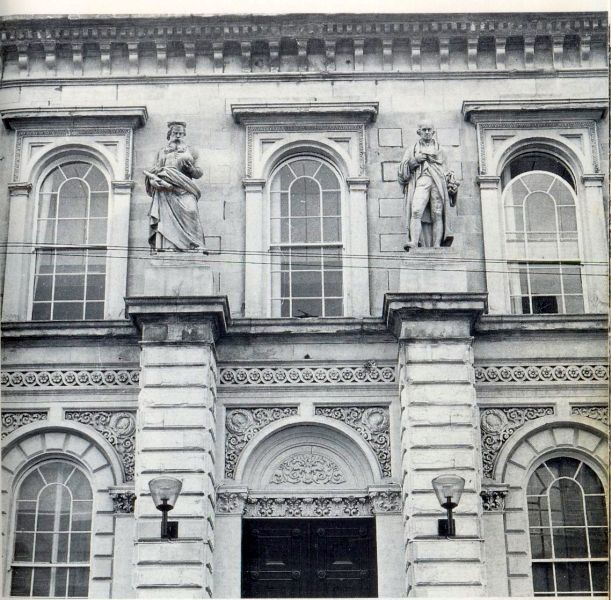 Strathclyde
House
|
|
St Aloysius' College in Glasgow city centre |
McLellan
Galleries in city centre of Glasgow
Built in 1856. The Galleries are named after their founder Archibald McLellan a coach builder, city councillor and patron of the arts. The Galleries are situated behind Sauchiehall Street and housed Glasgow School of Art from 1869 to 1899. |
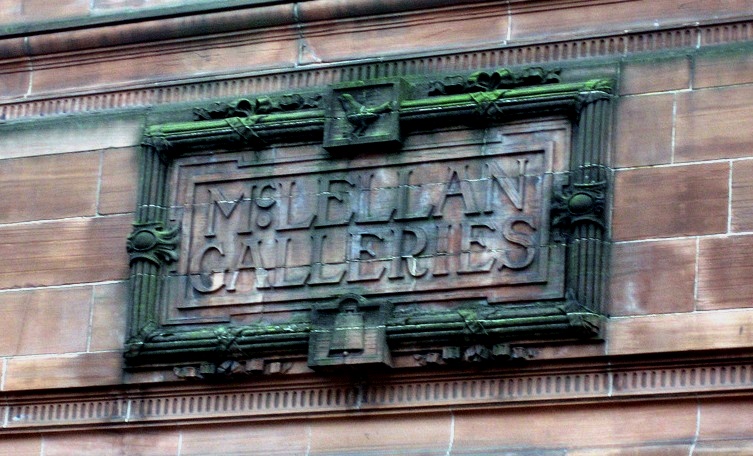 Carved
Nameplate on McLellan Galleries
|
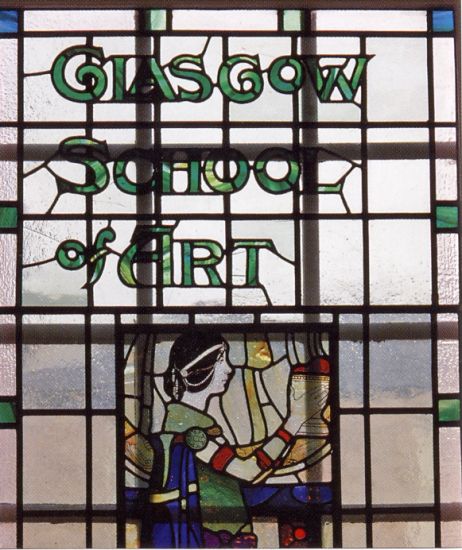 Stained
Glass Window
in the School of Art |
THE GLASGOW SCHOOL OF ART:
Charles Rennie Mackintosh was a young assistant at Honeyman and Keppie, a prominent architectural firm, when they won a competition
to design the Glasgow School of Art.
The project was entrusted to Mackintosh in spite of his being a junior employee. It was designed and built in phases between 1897 and 1909.
Today, the A-listed building, now known as The Mackintosh Building, which has been gutted by fire twice in the last decade, is
considered an outstanding example of Art Nouveau, ( also referred to as Modern Style or The Glasgow Style).
It is also one of the few examples of Mackintosh’s designs that were built, and considered “one of the world’s architectural treasures”
by the Royal Incorporation of Architects in Scotland.
Mackintosh is arguably Scotland’s most famous architect, and with influences from Japonisme, and architectural styles such as Scottish Baronial and Art Nouveau,
he created a magnificent and novel structure for the Glasgow School of Art.
Initially, the design was not popular, but in the intervening years has gone on to not only inspire universal admiration, but to influence architecture and design to the present day.
As in many other projects, Mackintosh worked with his wife on the design of the furnishings and interiors.
The building is described by the Charles Rennie Mackintosh Society as the architect’s “masterwork” and in 2009, the Mack, was voted Britain’s best building, by a
poll conducted by the RIBA journal.
The building, an elongated E-shape stretching along Renfrew Street, presents a simple, asymmetric volumetric mass to the street and is made of ‘snecked rubble’ sandstone from Giffnock,
with an ashlar finish.
Reminiscent of Scottish Baronial architecture, this facade is interspersed with huge windows, which without mullions, seem almost industrial in their design.
These large windows allow weak northern light into the large studios which lie behind.
The building is set behind a sunken basement area and a low stone wall, with wrought iron railings, where spars topped with roundels, present designs based on
diverse animal forms.
Wrought iron is also used for decorative features on the facade: there are brackets at the base of the first-floor windows, an arch over the sweeping entrance
steps and wrought iron railings crossing an oriel window, ( behind which sits the director’s room ) next to a rectangular two framed, transomed, arched window with a
segmental-headed pediment.
Above that, is the director’s studio, accessed by a stair within an attached, polygonal tower which extends above the top of the building.
The east and west elevations are narrower and present more detailed facades.
The Mackintosh Building, was seriously damaged in a fire in May 2014 and then almost destroyed in a second fire in 2018.
The board of governors of the GSA stated at the time that the Mackintosh Building would be rebuilt. “It will be as Mackintosh designed it, to the millimetre”.
The reconstruction process is now under way.
Dominion
House in West Regent Street
|
Glasgow Towers from Garnethill The Towers of Trinity College, Park Church |
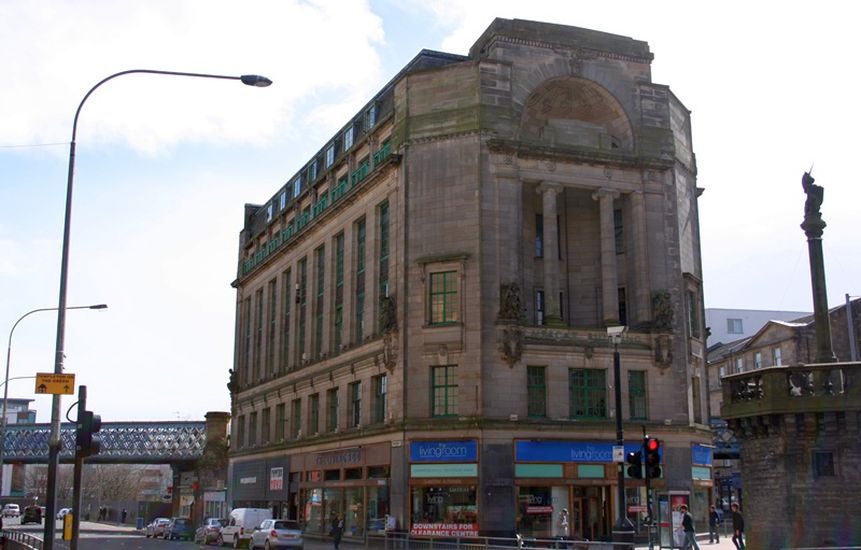
Gallowgate and Mercat Cross |
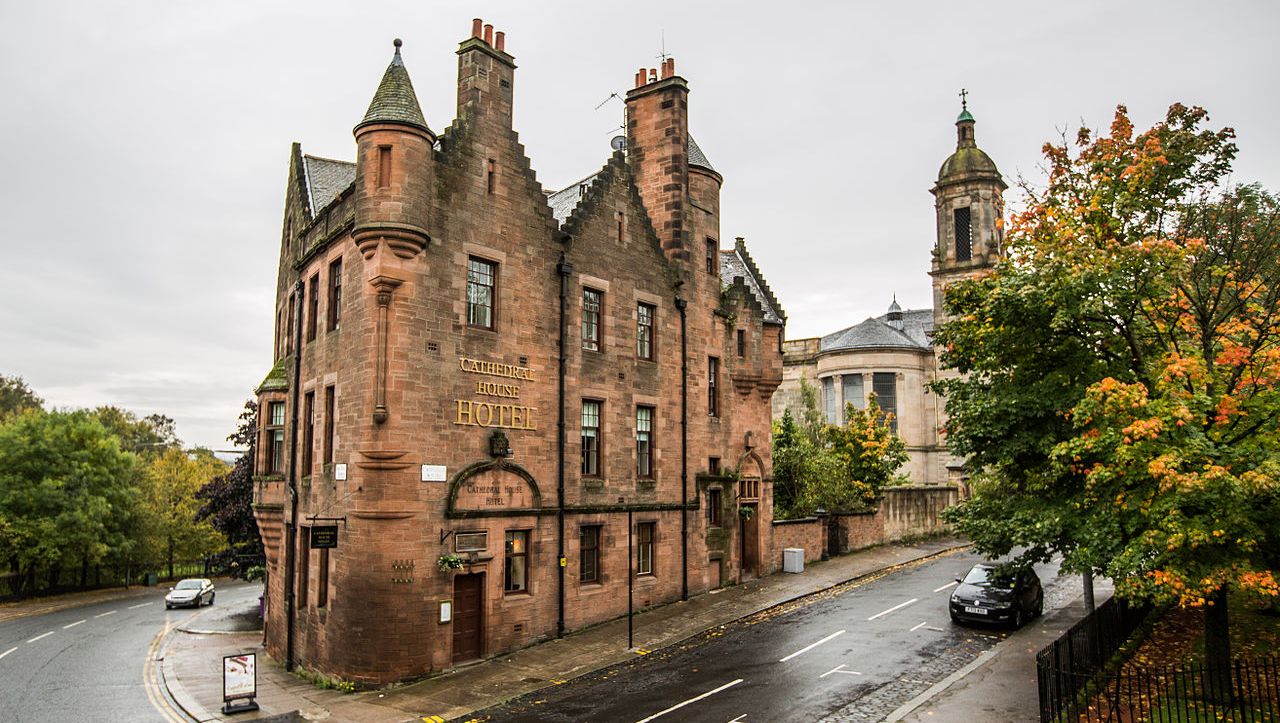
Cathedral House Hotel in Duke Street Cathedral
House was built in 1877 as a hostel for inmates released from nearby Duke Street Prison. As
Duke Street prison held women prisoners from
around Scotland, many Suffragettes and
political activists were imprisoned there whose protests at the
living conditions would eventually lead to its closure in 1955. Cathedral House was at this time a half way house for some of the female inmates. Duke
Street Prison was demolished in 1958 to eventually make way for the Ladywell housing scheme which was
built on the site from 1961–1964 and stands till this day. The only remaining structure of Duke Street Prison is some of the boundary wall. Cathedral House then became the property of the Glasgow Cathedral and was used for choir practice, Sunday school and
as living accommodation for some of the people which
worked for the Cathedral. Cathedral House became
a hotel approximately 30 years ago and was purchased by Shane and Laura McKenzie in October 2018 |
Holmwood
House
in the South Side of Glasgow Holmwood House is the finest and most elaborate residential villa designed by Alexander "Greek" Thomson. |
 :: Glasgow Buildings
Gallery
:: Glasgow Buildings
Gallery 
Glencoe | Ben Nevis | Knoydart | Isle of Skye | Isle of Arran | The West Highland Way
The Eastern Highlands | The Central Highlands | The Southern Highlands | The NW Highlands